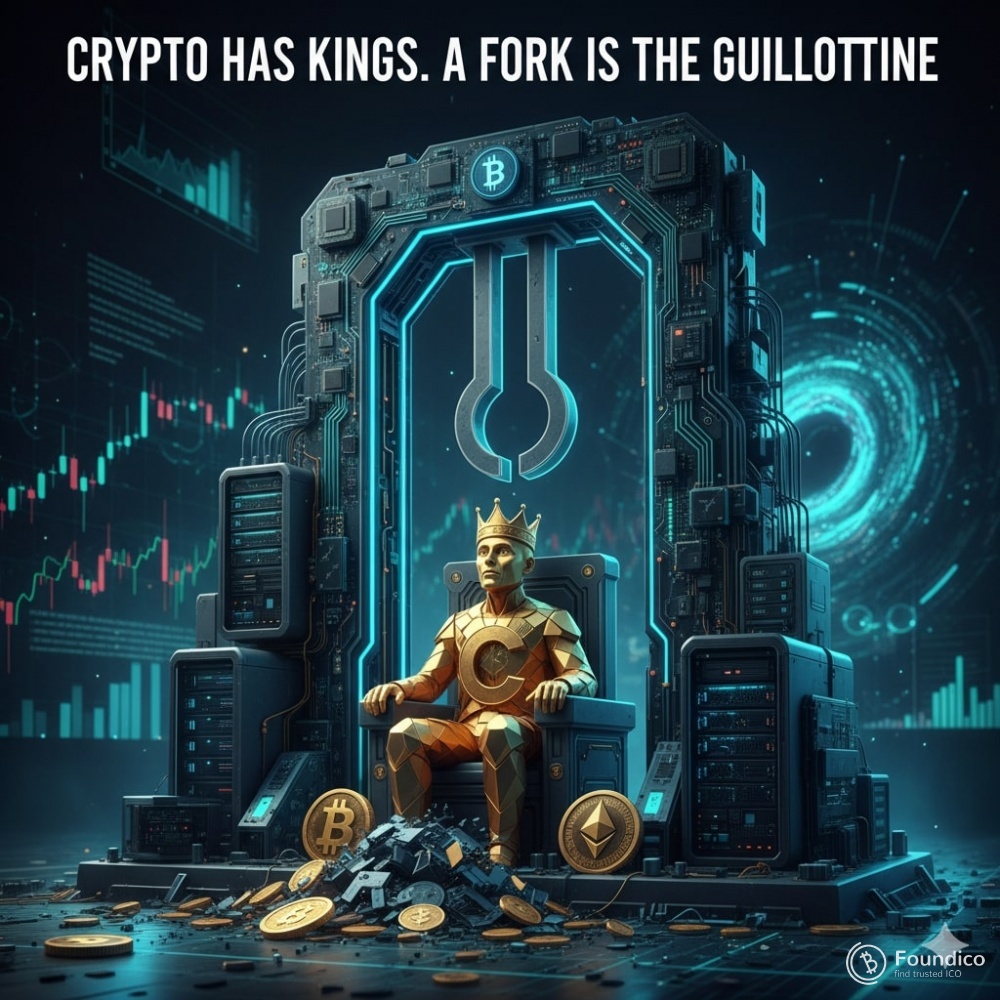Crypto Has Kings. A Fork Is the Guillotine

By Dr. Pooyan Ghamari, Swiss Economist and Visionary
In the sprawling digital realm of cryptocurrency, power concentrates like gold in a prospector’s pan. Bitcoin, Ethereum, and their ilk were born from a dream of decentralization—a rebellion against centralized control, promising a financial utopia where no single entity holds the reins. Yet, as the crypto ecosystem has matured, we’ve witnessed the rise of new monarchs: influential developers, billionaire whales, and charismatic figureheads who wield outsized influence over markets and protocols. These are the kings of crypto. But in this decentralized world, there’s a guillotine sharp enough to topple them—a fork.
The Rise of Crypto Kings
The crypto landscape, despite its egalitarian roots, is not immune to hierarchy. Power coalesces around those who control code, capital, or charisma. Core developers, like Ethereum’s Vitalik Buterin or Bitcoin’s early contributors, hold sway over protocol upgrades and technical direction. Their decisions ripple across markets, shaping the future of entire networks. Whales—those with massive holdings—can move prices with a single trade, their wallets casting long shadows over market sentiment. Then there are the influencers, the loud voices on platforms like X, whose tweets can spark rallies or crashes.
These kings aren’t crowned by divine right but by influence, wealth, or technical prowess. Yet their power is real. A developer’s commit to a GitHub repository can alter a blockchain’s rules. A whale’s sell-off can tank a token’s value. An influencer’s endorsement can send a memecoin to the moon. In a system designed to distribute power, these figures have become de facto rulers, their actions shaping the crypto world more than the average user’s.
The Fork: A Revolutionary Blade
But crypto is not a monarchy bound by tradition. It’s a living, breathing system where dissent can take tangible form: the fork. A fork—whether soft or hard—is the ultimate check on power. It’s a mechanism where the community, or a faction of it, can reject the direction imposed by the kings and chart a new course. When developers push an upgrade that consolidates their control, when whales manipulate markets, or when influencers steer sentiment for personal gain, a fork offers a way to reset the board.
A hard fork, in particular, is the guillotine. It splits a blockchain into two, forcing participants to choose sides. Bitcoin Cash, born from Bitcoin in 2017, was a rebellion against scaling decisions favored by Bitcoin’s core developers. Ethereum’s split from Ethereum Classic in 2016 followed a contentious decision to reverse a hack, pitting pragmatists against purists. These forks weren’t just technical divergences; they were acts of defiance, proof that no king is untouchable.
The Power of the People
Forks embody the radical heart of crypto: the ability to say “no” and build something new. Unlike traditional finance, where centralized institutions like banks or governments dictate terms, crypto empowers its users to rewrite the rules. A fork doesn’t require permission from a king—it requires only consensus among enough participants. Miners, node operators, and users collectively decide which chain survives, redistributing power in a way no centralized system could match.
This is where crypto’s true strength lies. The kings may hold sway today, but their thrones are fragile. A fork is a reminder that power in crypto is not absolute—it’s contingent on the community’s will. When the kings overreach, when their decisions alienate the masses, the guillotine falls. The blockchain splits, and the old regime is left ruling a ghost chain, while the new one carries forward.
The Fragile Crown
The existence of forks doesn’t eliminate crypto’s kings—it tempers their power. Every decision they make is shadowed by the possibility of rebellion. Developers must tread carefully, balancing innovation with community consensus. Whales must weigh the risk of triggering a backlash that devalues their holdings. Influencers must know their words could spark a schism rather than a surge. The threat of a fork keeps the ecosystem dynamic, preventing any single entity from becoming an unchallenged monarch.
Yet forks are not without cost. They fracture communities, dilute value, and sow confusion. A successful fork requires coordination, conviction, and enough support to sustain a new chain. Not every rebellion succeeds—many forked chains fade into obscurity, their supporters scattered. But the mere possibility of a fork ensures that crypto remains a space where power is contested, not cemented.
A Vision for Balance
As crypto evolves, the tension between kings and forks will define its future. The vision of decentralization demands vigilance—users must stay engaged, nodes must remain decentralized, and the community must be ready to wield the guillotine when needed. The kings of crypto are not the enemy; their expertise, wealth, and influence can drive progress. But unchecked, they risk turning a decentralized dream into a feudal reality.
A fork is more than a technical act—it’s a philosophical one. It’s a declaration that no one owns the future of crypto. The guillotine doesn’t just cut down kings; it carves out space for new ideas, new voices, and new possibilities. In a world of digital gold, the fork is the sharpest tool we have to keep power in check.
Dr. Pooyan Ghamari is a Swiss economist and visionary, exploring the intersections of technology, finance, and human freedom.

 Best Wallet - Best Wallet Token, revolutionizing the Web3 experience. $BEST token reduces transaction fees, grants exlusive early access to the hottest presales and gamifies wallet engagement.
Best Wallet - Best Wallet Token, revolutionizing the Web3 experience. $BEST token reduces transaction fees, grants exlusive early access to the hottest presales and gamifies wallet engagement.